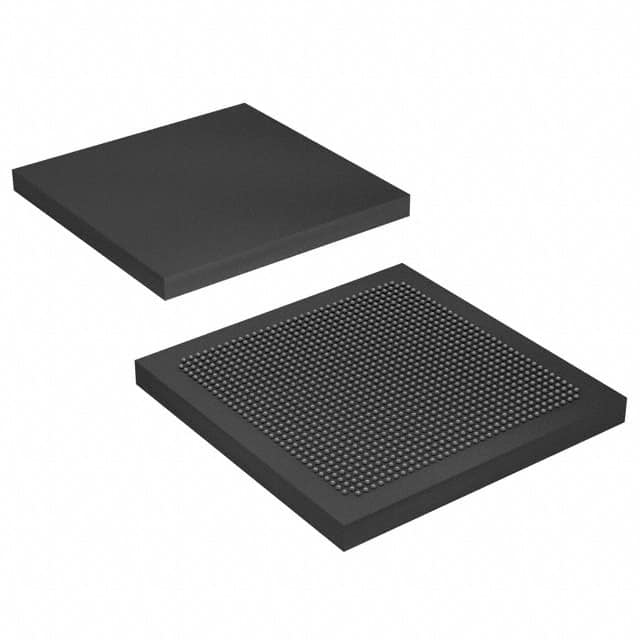Consulte las especificaciones para obtener detalles del producto.

5SGXMA7K2F35C3
Basic Information Overview
- Category: Integrated Circuit (IC)
- Use: Programmable Logic Device (PLD)
- Characteristics: High-performance, high-density, low-power consumption
- Package: Flip-chip BGA (Ball Grid Array)
- Essence: Field-Programmable Gate Array (FPGA)
- Packaging/Quantity: Single unit
Specifications
- Logic Elements: 352,000
- Embedded Memory: 8,062 Kbits
- DSP Blocks: 1,288
- Maximum User I/O Pins: 622
- Operating Voltage: 1.2V
- Operating Temperature: -40°C to +100°C
- Package Dimensions: 35mm x 35mm
Detailed Pin Configuration
The 5SGXMA7K2F35C3 has a complex pin configuration with multiple pins dedicated to various functions. A detailed pinout diagram can be found in the product datasheet.
Functional Features
- High-performance architecture for demanding applications
- Flexible and reconfigurable design
- Support for advanced digital signal processing algorithms
- Low-power consumption for energy-efficient operation
- High-speed serial transceivers for fast data transfer
- Built-in memory blocks for efficient data storage
Advantages
- Versatile and adaptable for a wide range of applications
- Large number of logic elements for complex designs
- High-speed interfaces for rapid data communication
- Low power consumption for energy-efficient operation
- Ample embedded memory for data storage
Disadvantages
- Complex pin configuration may require careful planning during design
- Higher cost compared to simpler programmable logic devices
- Steeper learning curve for beginners due to its advanced features
Working Principles
The 5SGXMA7K2F35C3 is based on the field-programmable gate array (FPGA) technology. It consists of a large number of configurable logic elements interconnected through programmable routing resources. These logic elements can be programmed to implement various digital circuits and functions. The device can be reprogrammed multiple times, allowing for flexibility in design and functionality.
Detailed Application Field Plans
The 5SGXMA7K2F35C3 is suitable for a wide range of applications, including: - High-performance computing - Digital signal processing - Communications systems - Industrial automation - Aerospace and defense - Video and image processing
Detailed and Complete Alternative Models
- 5SGXEA7K2F35C3: Similar specifications but with lower logic elements and DSP blocks.
- 5SGXEB7K2F35C3: Similar specifications but with higher logic elements and embedded memory.
- 5SGXEC7K2F35C3: Similar specifications but with additional high-speed serial transceivers.
(Note: This list is not exhaustive and there may be other alternative models available.)
This entry provides an overview of the 5SGXMA7K2F35C3, a high-performance programmable logic device. It includes basic information, specifications, pin configuration, functional features, advantages and disadvantages, working principles, application field plans, and alternative models.
Enumere 10 preguntas y respuestas comunes relacionadas con la aplicación de 5SGXMA7K2F35C3 en soluciones técnicas
Sure! Here are 10 common questions and answers related to the application of 5SGXMA7K2F35C3 in technical solutions:
Q: What is the 5SGXMA7K2F35C3 FPGA used for? A: The 5SGXMA7K2F35C3 FPGA is commonly used for high-performance applications that require advanced processing capabilities.
Q: What are some typical applications for the 5SGXMA7K2F35C3 FPGA? A: Some typical applications include telecommunications, networking, industrial automation, video processing, and high-performance computing.
Q: What are the key features of the 5SGXMA7K2F35C3 FPGA? A: The key features include a large number of logic elements, high-speed transceivers, embedded memory blocks, DSP blocks, and support for various communication protocols.
Q: Can the 5SGXMA7K2F35C3 FPGA be reprogrammed? A: Yes, FPGAs are programmable devices, and the 5SGXMA7K2F35C3 can be reprogrammed multiple times to implement different functionalities.
Q: How does the 5SGXMA7K2F35C3 FPGA compare to other FPGAs in its class? A: The 5SGXMA7K2F35C3 offers a good balance between logic capacity, performance, and power consumption, making it suitable for a wide range of applications.
Q: What development tools are available for programming the 5SGXMA7K2F35C3 FPGA? A: Intel Quartus Prime is the recommended software toolchain for designing, programming, and debugging the 5SGXMA7K2F35C3 FPGA.
Q: Can the 5SGXMA7K2F35C3 FPGA interface with other components or devices? A: Yes, the FPGA supports various communication protocols such as PCIe, Ethernet, USB, and DDR memory interfaces, allowing it to interface with other components or devices.
Q: What is the power consumption of the 5SGXMA7K2F35C3 FPGA? A: The power consumption depends on the specific design and usage scenario, but the 5SGXMA7K2F35C3 FPGA is designed to be power-efficient.
Q: Are there any reference designs available for the 5SGXMA7K2F35C3 FPGA? A: Yes, Intel provides reference designs and application notes that can help developers get started with implementing their solutions using the 5SGXMA7K2F35C3 FPGA.
Q: Where can I find technical support or documentation for the 5SGXMA7K2F35C3 FPGA? A: Intel's website offers comprehensive technical documentation, user guides, datasheets, and a community forum where you can seek assistance and support for the 5SGXMA7K2F35C3 FPGA.

